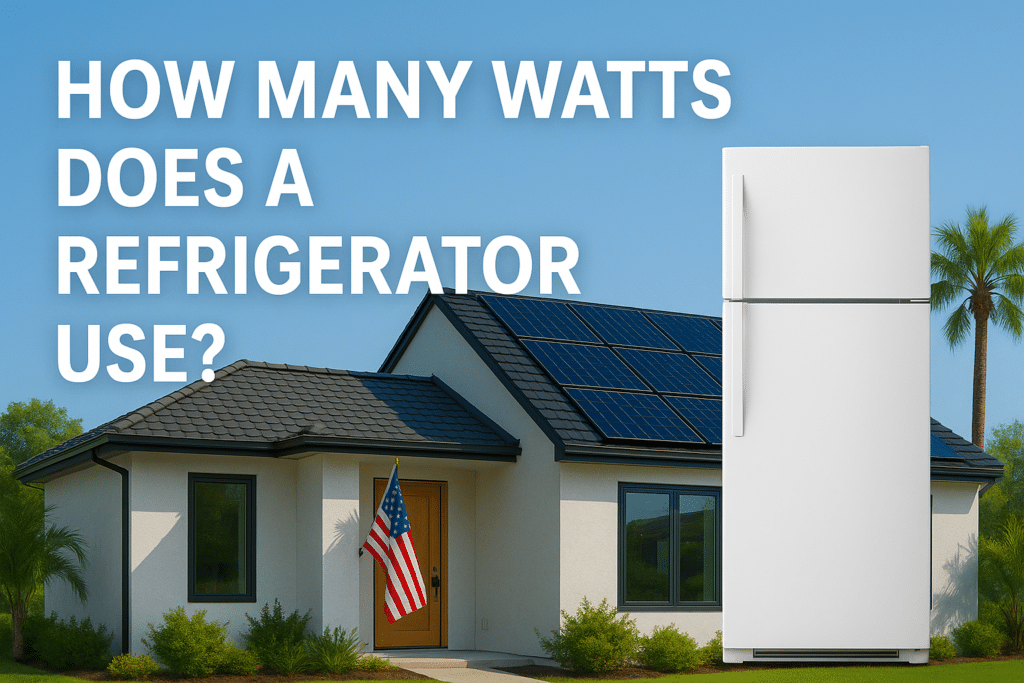
Knowing how many watts your refrigerator uses is a key part of the equation if you’re trying to reduce your energy bill or size a solar system for your home. But the answer isn’t as simple as one number. It depends on the type, size, efficiency rating, and even how full your fridge is.
In this updated 2025 guide, we’ll walk you through everything you need to know, including real-world data, tips for solar users, and how to reduce energy waste.
Average Refrigerator Wattage (2025)
Refrigerators don’t run continuously at full power. They cycle on and off to maintain temperature, so the average usage is far lower than peak wattage. Below is a breakdown of typical wattage by fridge type:
| Refrigerator Type | Average Running Watts | Startup Surge Watts | Estimated Annual Usage (kWh) | Energy Star Certified |
|---|---|---|---|---|
| Mini Fridge (1.7–4.5 cu. ft.) | 50–100 W | 200–300 W | 200–350 kWh | Often |
| Top-Freezer (16–20 cu. ft.) | 100–400 W | 800–1200 W | 350–600 kWh | Yes |
| Bottom-Freezer (18–25 cu. ft.) | 120–500 W | 1000–1500 W | 400–650 kWh | Yes |
| French Door (25–30+ cu. ft.) | 180–600 W | 1200–2000 W | 500–800+ kWh | Usually |
| Commercial Fridge or Display Case | 500–1000+ W | 2000+ W | 1000–3000+ kWh | Rarely |
Disclaimer: Wattage and kWh data are based on manufacturer specifications, public databases, and energy test reports as of 2025. Real-world results may vary depending on usage, environment, and product age.
How Many Solar Panels Do You Need to Run a Refrigerator?
Let’s take a common example: a 400-watt top-freezer refrigerator.
- Daily Energy Usage:
400W × 8 hours = 3.2 kilowatt-hours per day
(Note: Many fridges cycle and only run 6–8 hours/day) - Solar Requirement:
If your area gets 5 sun hours/day, you’ll need:
→ 650 to 800 watts of solar panel capacity - Battery Backup Recommendation:
→ 3.2 to 4 kWh of battery storage to run the fridge overnight or during cloudy days
If you’re designing an off-grid system or backup power setup, always consider surge wattage and efficiency loss (about 10–15%).
What’s New in 2025? Key Refrigerator Efficiency Trends
Energy-efficient fridges have come a long way in recent years. Here’s what’s changed:
- Inverter Compressors
Compressors now ramp up and down instead of running at full power constantly. This reduces both energy use and wear. - Eco Mode and Smart Temperature Sensors
New models can adapt cooling cycles to your habits and even enter power-saving mode when you’re away. - Updated ENERGY STAR Criteria
The 2025 standards are stricter than ever, trimming average consumption by 10–15% from the 2020 baseline. - Better Refrigerants
R-600a has replaced older refrigerants like R-134a. It cools faster and uses less energy.
Real-World Examples: Popular 2025 Fridges and Their Energy Use
Here are a few current models and their manufacturer-reported specs to give you a sense of what’s typical:
| Brand + Model | Size | Estimated Annual kWh | Daily Cost (at $0.17/kWh) |
|---|---|---|---|
| LG LFXS26973S (French Door) | 26 cu. ft. | 665 kWh | $0.31/day |
| Whirlpool WRT518SZFM (Top-Freezer) | 18 cu. ft. | 410 kWh | $0.19/day |
| GE GME04GLKLB (Mini Fridge) | 4.4 cu. ft. | 234 kWh | $0.11/day |
| EcoSolar CoolBox (12V solar fridge) | 1.7 cu. ft. | 150 kWh | $0.07/day |
Note: These are estimates based on 2025 public listings. Your actual usage may differ based on temperature, location, and how often you open the fridge.
How to Find Out How Many Watts Your Fridge Uses
Here are four simple ways to check:
- Read the Label
Look inside your fridge or on the back panel for voltage and amps. Multiply them:
Watts = Volts × Amps - Use a Kill-A-Watt Meter
This plug-in tool gives a real-time readout of power usage. - Check the Manufacturer’s Website
Search the model number for detailed energy specs and EnergyGuide labels. - Smart Plugs and Monitors
Wi-Fi-enabled devices like Emporia, Sense, or Kasa plugs can track long-term usage.
Simple Ways to Cut Fridge Energy Costs
Even if you’re not ready to replace your refrigerator, small changes can make a noticeable difference:
- Don’t Overcool – 37–40°F is ideal for the fridge, 0°F for the freezer
- Keep It Full – Cold food helps regulate the temperature more efficiently
- Clean the Coils – Dusty coils can raise energy use by up to 15%
- Check the Door Seal – A worn-out gasket leaks cold air
- Defrost Regularly – If you have a manual defrost unit, ice buildup reduces efficiency
Final Thoughts for Solar-Powered Homes
Refrigerators are one of the few appliances that need to run 24/7, which makes them a key factor in solar system design. Here’s what we recommend:
- Choose a modern, ENERGY STAR-certified model
- Consider inverter-based DC refrigerators for off-grid or tiny homes
- Factor in surge wattage when sizing your inverter
- Use solar monitoring tools to optimize energy use
With thoughtful planning, your fridge can run reliably and efficiently — even on 100% solar power.
Sources
- U.S. Department of Energy – Appliance Energy Calculator
- ENERGY STAR – Refrigerator Standards & Requirements
- Manufacturer Data Sheets: LG, GE, Whirlpool, EcoSolar
- NREL – PVWatts Calculator

